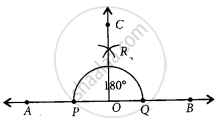Advertisements
Advertisements
प्रश्न
Bisect a straight angle, using ruler and compasses. Measure each part.
उत्तर

Steps of construction:
(i) Draw a line AB of any length.
(ii) Draw an arc of 180° which meets the ray `vec(OA)` at P and ray `vec(OB)` at Q.
(iii) Taking P and Q as centres and radius more than `1/2 (hat(PQ))`, draw two arcs which intersect each other at R.
(iv) Join OR and produce it to any point C.
(v) Thus, `vec(OC)` bisect the straight angle. Now, on measuring each angle we get, ∠BOC = ∠AOC = 90°.
APPEARS IN
संबंधित प्रश्न
Draw a line segment AB = 6.2 cm. Mark a point P in AB such that BP = 4 cm. Through point P draw perpendicular to AB.
Draw a line segment of length 7 cm. Draw its perpendicular bisector, using ruler and compasses.
Copy figure on your notebook and draw a perpendicular from P to line m using (i) set squares (ii) protractor (iii) ruler and compass. How many such perpendicular are you able to draw?
Bisect ∠XYZ of figure.
Draw an angle of 60° using ruler and compasses and divide it into four equal parts. Measure each part.
Bisect a right angle, using ruler and compasses. Measure each part. Bisect each of these parts. What will be the measure of each of these parts?
Draw a line segment of length 10 cm. Divide it into four equal parts. Measure each of these parts.
Draw the perpendicular bisector of `overline"XY"` whose length is 10.3 cm.
- Take any point P on the bisector drawn. Examine whether PX = PY
-
If M is the midpoint of `overline"XY"`, what can you say about the lengths MX and XY?
With `overline"PQ"` of length 6.1 cm as diameter, draw a circle.
Draw a circle of radius 4 cm. Draw any two of its chords. Construct the perpendicular bisectors of these chords. Where do they meet?
